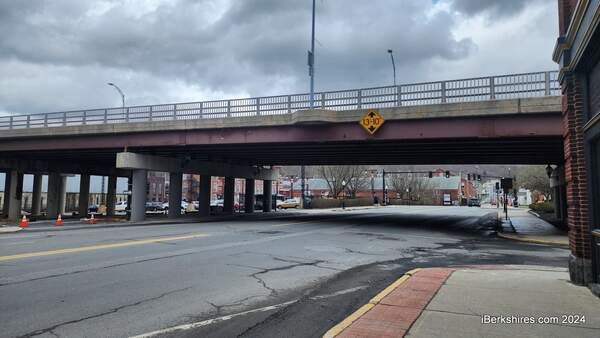Fourth-Graders Learn Local History of Underground Railroad
WILLIAMSTOWN, Mass. — A group of fourth-graders from Williamstown Elementary School last week explored Berkshire vestiges of the Underground Railroad.
They hiked through woods where escaping slaves once trekked to freedom and they viewed a monument near the Berkshire Mall that memorializes those long-ago freedom seekers.
The youngsters said if they had lived in the early to mid-19th century they would have been abolitionists, and that they admired the Quakers, early settlers in Adams, who helped the fugitives on their journey north.
"We never knew there was so much right around here," said Krissy Morin and Simone Rodriguez, class members who discussed their trip last Thursday with a reporter yesterday at their school. "We saw graves where slaves were buried," said Krissy.
The Quakers' graves in the Adams burial ground were marked; the slave graves were unmarked.
Kevin Varney said he was surprised that the memorial was just outside the Berkshire Mall. The Tucker Todd Homesite near Route 8 and the Berkshire Mall, was a well-known station for slaves and was known as The Place. The memorial stone there refers to the "Gulf," which is an area traversed by Gulf Road from Lanesborough to Dalton. The marker "to Black Americans who lived in or passed through the Gulf" can be seen, just off the mall ring road, on the Route 8 side quite near the mall's northern access road.
And Joslyn Juif said she was surprised to learn the historical importance of the graves in the woods on Anthony family property, near where she often visits at her grandmother's house.
The youngsters all said they are glad to know more about their area as a result of their trip and their study. And all are eager to launch more explorations. Their study of the Underground Railroad in this area will be part of the History Fair, with projects and performances by all four schools in town, the elementary school, Mount Greylock Regional, including participation by the private schools, Pine Cobble and Buxton. The fair, part of the town's 250th anniversary celebration, will be Friday from 1 to 5 p.m. and Saturday from 9 to noon.
Teacher Carolyn Agostini said the students' study of the Underground Railroad was launched by reading "Meet Addy," an American Girl book about a young girl who had escaped from slavery.
"We asked 'was it up here? and why?' and we did more research," said Agostini.
The youngsters started their explorations Thursday at the Williamstown House of Local History, where curator Nancy Burstein recounted local lore and the contributions of long-ago residents, both conductors, and escaped slaves who settled in the area as free men.
Kevin Varney told this reporter the origin of the term Underground Railway, stemming from the invention of the steam railroad locomotive and the escape of a runaway slave named Tice Davids who crossed the Ohio River from Kentucky and disappeared. People began to say that Davids had escaped on an "underground railroad," and the name stuck because the "railroad" was secret, invisible, and seemed to run swiftly.
Cheshire Harbor, north of Cheshire Lake on the Hoosac River near the railroad tracks, is believed to take its name because its inhabitants were known to harbor fugitive slaves. The Quaker Meeting House is relatively nearby, and Quakers were very active in guiding slaves to freedom, signaling by putting lanterns in windows for those traveling at night, or displaying quilts with coded messages. Everyone helping the runaways was breaking the Fugitive Slave Law of 1850, meaning that they risked paying a fine or jail terms, and the runaway slaves could be sent back to captivity.
Quakers, many of whom settled in Adams, opposed war and slavery, believed in equality, and let runaway slaves use their homes and barns on their journey to freedom.
According to historical sources, in Williamstown, Dr. Henry L. Sabin would secretly care for fugitive salves and furnish them with a guide to meet the next conductor, Dr. Henry P. Phillips of North Adams. Dr. Phillips contributed to their expenses and saw to it that they were safely transported over Hoosac Mountain by night to Dr. Fiske of Greenfield.
Also, young Berkshire boys, including Alonzo Cummings of Cheshire, drove fugitives, hidden among blankets in their wagons. A Williamstown lawyer was connected to the landmark case in which Elizabeth Freeman of Sheffield in 1781 sued for her freedom from Col. John Ashley, testing the constitutionality of slavery under the new Massachusetts constitution. Williamstown lawyer David Noble defended the slave owner and lost, making Elizabeth Freeman among the first African-Americans in Massachusetts and the United States to be freed.
Samuel H. Robinson, born a slave in Maryland in 1814, was said to have "made himself wings and flew away," settling in Williamstown in 1855, and opening a barbershop here. Fugitive slaves were also said to shelter in caves around Bellow's Pipe and Notch Road.
"When we walked through the woods in Cheshire Harbor, the children felt it was a spiritual place," Agostini said.
Besides the House of Local History, Agostini credited the Berkshire County Historical Society and Williams College for help with research. Many individuals were also helpful, she said.
Tags: historic sites, historical, underground railroad,
















